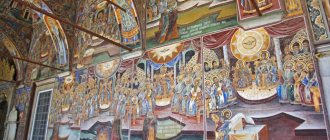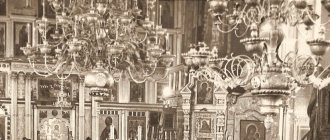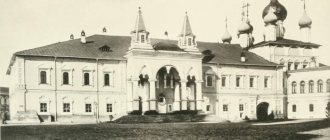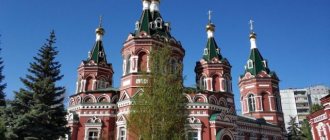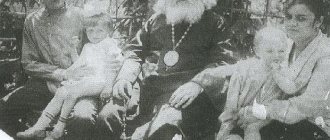| Sight | |
| Priest's house | |
| A country | Russia |
| City | Moscow |
| State | Valid |
Priest's house
- administrative building of the Russian Orthodox Old Believer Church. Part of the historical and architectural ensemble “Rogozhskaya Sloboda”, a monument of history and culture of the 19th century.
Story
The plan, dating from 1821, shows a building whose dimensions are similar to part of the modern Priest's House[1]. The current building was built in 1863-1866[2].
On the lower floor there were: a cemetery office-hotel, an office for the cemetery trustees, a kitchen for preparing funeral services, and a warehouse for church supplies. The office also housed the archives of the Rogozhskoe cemetery. On the top floor there were two huge halls for meetings, funeral arrangements, recreation for visitors and rooms occupied by Rogozh schools: a city 4-grade school and an elementary school. This was once one of the most comfortable buildings of the Rogozhsky cemetery[3]. In the second half of the 19th century, here were the chambers of the Moscow Old Believer Archbishop of Moscow and All Rus', Consecrated Councils, All-Russian Congresses of Laymen and Representatives of Church Communities took place[1].
After the revolution it was used as a school in the late 1920s. transferred to a student dormitory, then became a residential building. In the post-war years it again became a hostel[3].
In the fall of 1987, as a result of a fire, the building fell into disrepair - only the walls remained from the building[3]. The residents were resettled[1].
In December 1987, the Parish House, in its post-fire condition, was leased to the Moscow Archdiocese (since 1988 - the Moscow Metropolis). However, as a result of a lawsuit, the lease agreement for the building was interrupted, and only in 1996, after numerous lengthy litigations, the building, already in a completely ruined state, was returned to the use of the Metropolis of the Russian Orthodox Old Believer Church. At that time, the RPSC did not have the means to restore the building, and year after year it was increasingly destroyed and fell into disrepair[1].
Only Metropolitan Andrian (Chetvergov) managed to attract the attention of the Moscow authorities to this problem. In March 2005, the then mayor Yuri Luzhkov arrived in Rogozhskoye and gave the go-ahead for the reconstruction of the Rogozhsky historical and architectural complex[1]. During a meeting between Yuri Luzhkov and Metropolitan Andrian, it was decided in the summer of that year to begin examining the foundation of the Clergy House and strengthening it. Yuri Luzhkov gave instructions to prepare projects for the restoration of the buildings of the Parish House and the Church of the Nativity of Christ. The mayor also drew attention to the fact that numerous fences and bars dividing the internal territory of the Rogozhskaya Sloboda interfere with its perception as a single whole, which need to be removed, and in return, the historical zone should be protected with a common fence that would “look decent, in the spirit of the old regime”[4]
Work on the reconstruction and restoration of the building began only in 2010. When strengthening the foundation, wells were drilled around the perimeter of the building; pumps pumped water out of the wells during the process of casting a new foundation, thus lowering the groundwater level - now the building actually stands on a sealed reinforced concrete “glass.” The façade of the building was restored, and the builders managed to almost completely preserve the northern façade of the house in its original form; it suffered the least damage during the years of neglect[2]. It was assumed that the Clergy House would be finally put into operation in July 2012[5].
On October 31, 2013, a permanent exhibition of the Museum of Old Believer Icons opened in the restored building of the Clergy House. The exhibition presents icon-painting monuments of the 16th-20th centuries from the collection of the Rogozhsky icon depository[6].
On April 24, 2015, Metropolitan Korniliy (Titov) of Moscow and All Rus' On April 24, Metropolitan Korniliy performed a prayer service with the blessing of water in the restored House of Clergy, which became the administrative building of the Russian Orthodox Church[1].
In October 2015, Metropolitan Cornelius, speaking at the Consecrated Council in Moscow, said: “The House of the Clergy, which was badly damaged and changed its appearance in the last century, was literally recreated from oblivion. Now our Consecrated Councils are held in it; in a short period of time after its transfer to us, several significant exhibitions and conferences on the Old Believers and the history of Russian culture have already taken place here. Yesterday an exhibition of ancient sewing and vestments was opened.”[7].
House churches: where they can be located
- In hospitals and clinics. Of course, there are full-fledged small churches on the territory of some hospitals. But where there is no possibility or purpose to erect a separate building, house temples are built. They are arranged primarily for patients and staff.
- In military units. For military personnel.
- In educational institutions. Now - mainly at theological academies. But not only. For example, there is a large house church at Moscow State University on Vozdvizhenka. House churches at institutes are an old tradition that carries the idea of spiritual education for students.
- In monasteries, house churches can be located in any auxiliary or service buildings. They, as a rule, play the role of “small” churches, in which services are held “on occasion” (for example, on the days of major Holidays or the memory of saints in whose honor the temple is consecrated).
- In private homes. They probably don’t do this now, but before the revolution, a very rich landowner could place a house church in one of his mansions.
- In government premises. For example, there is a house church in the building of the Accounts Chamber of the Russian Federation in Moscow.
Patriarchal service in the house Church of the Three Saints in Paris. Photo: patriarchia.ru
Notes
- ↑ 123456
[rpsc.ru/news/novosti-mitropolii/osvyashhenie-doma-prichta-na-rogozhskom/" Consecration of the new administrative building of the Metropolis of the Russian Orthodox Old Believer Church] - ↑ 12
[mosday.ru/news/item.php?136775 Moscow | News | The restoration of the clergy house for the Old Believer Church will be completed before January - MosDay.ru] - ↑ 123
[www.openmoscow.ru/kladbrogozh.php Sights of Moscow: Rogozhsky Old Believer village and Rogozhsky Old Believer cemetery. Rogozhsky village, st., 29, metro station “Marksistskaya”, “Taganskaya”, “Aviamoto...] - [rpsc.ru/news/mitropolit-andrian-i-mer-moskvyi-yum-luzhkovproveli-soveschanie-o-buduschem-rogozhskoy-slobodyi/ » Metropolitan Andrian and Moscow Mayor Yu.M. Luzhkov held a meeting on the future of Rogozhskaya Sloboda Russian Orthodox Old Believer Church]
- [rpsc.ru/news/rukovoditel-departamenta-kulturnogo-naslediya-stolici-aleksandr-kibovskij-s-rabochim-vizitom-posetil-rogozhskoe/ » The head of the capital’s cultural heritage department, Alexander Kibovsky, visited the Rogozhskoye Russian Orthodox Old Believer Church on a working visit]
- [rpsc.ru/news/na-rogozhskom-otkrilas-muzejnaya-ekspoziciya-staroobryadcheskoj-ikoni/ » A museum exhibition of an Old Believer icon of the Russian Orthodox Old Believer Church has opened on Rogozhsky]
- [rpsc.ru/mitropolit/vistupleniya/doklad-osvyashhennomu-soboru-russkoj-pravoslavnoj-staroobryadcheskoj-tserkvi-2015-g/ » Report to the Consecrated Council of the Russian Orthodox Old Believer Church (2015) Russian Orthodox Old Believer Church]
House churches: what are they?
If someone says that a house church is somehow “worse” than ordinary churches, then this is not true. All churches are equal, the Holy Liturgy is served in each.
Another thing is that, as a rule, house churches are small and less luxurious in architectural forms or decoration (although there are exceptions). But these are all human circumstances that in no way affect the depth of spiritual life or the essence of the Sacraments. Saints and early Christians sometimes took communion in ordinary caves.
Excerpt characterizing the Priest's House
Countess Rostova with her daughters and already a large number of guests was sitting in the living room. The Count led the male guests into his office, offering them his hunting collection of Turkish pipes. Occasionally he would go out and ask: has she arrived? They were waiting for Marya Dmitrievna Akhrosimova, nicknamed in society le terrible dragon, [a terrible dragon,] a lady famous not for wealth, not for honors, but for her directness of mind and frank simplicity of manner. Marya Dmitrievna was known by the royal family, all of Moscow and all of St. Petersburg knew her, and both cities, surprised by her, secretly laughed at her rudeness and told jokes about her; nevertheless, everyone without exception respected and feared her. In the office, full of smoke, there was a conversation about the war, which was declared by the manifesto, about recruitment. No one had read the manifesto yet, but everyone knew about its appearance. The Count was sitting on an ottoman between two neighbors who were smoking and talking. The count himself did not smoke or speak, but tilting his head, now to one side, now to the other, looked with visible pleasure at those smoking and listened to the conversation of his two neighbors, whom he pitted against each other. One of the speakers was a civilian, with a wrinkled, bilious and shaved thin face, a man already approaching old age, although dressed like the most fashionable young man; he sat with his feet on the ottoman with the air of a domestic man and, throwing amber far into his mouth from the side, impulsively inhaled the smoke and squinted. It was the old bachelor Shinshin, the countess's cousin, an evil tongue, as they said about him in Moscow drawing rooms. He seemed to condescend to his interlocutor. Another, fresh, pink, guards officer, impeccably washed, buttoned up and combed, held amber in the middle of his mouth and lightly pulled out smoke with his pink lips, releasing it in ringlets from his beautiful mouth. This was Lieutenant Berg, an officer of the Semenovsky regiment, with whom Boris rode together in the regiment and with whom Natasha teased Vera, the senior countess, calling Berg her fiancé. The Count sat between them and listened attentively. The most enjoyable activity for the Count, with the exception of the game of Boston, which he loved very much, was the position of listening, especially when he managed to pit two talkative interlocutors against each other. “Well, of course, father, mon tres honorable [most venerable] Alfons Karlych,” said Shinshin, laughing and combining (which was the peculiarity of his speech) the most popular Russian expressions with refined French phrases. – Vous comptez vous faire des rentes sur l'etat, [You expect to have income from the treasury,] do you want to receive income from the company? - No, Pyotr Nikolaich, I just want to show that cavalry has much less benefits against infantry. Now imagine, Pyotr Nikolaich, my situation... Berg always spoke very precisely, calmly and courteously. His conversation always concerned himself alone; he always remained calmly silent while they were talking about something that had nothing directly to do with him. And he could remain silent in this way for several hours without experiencing or causing the slightest confusion in others. But as soon as the conversation concerned him personally, he began to speak at length and with visible pleasure. - Consider my position, Pyotr Nikolaich: if I were in the cavalry, I would receive no more than two hundred rubles a third, even with the rank of lieutenant; and now I get two hundred and thirty,” he said with a joyful, pleasant smile, looking at Shinshin and the count, as if it was obvious to him that his success would always be the main goal of the desires of all other people. “Besides, Pyotr Nikolaich, having joined the guard, I am visible,” Berg continued, “and vacancies in the guards infantry are much more frequent.” Then, figure out for yourself how I could make a living out of two hundred and thirty rubles. “And I’m putting it aside and sending it to my father,” he continued, starting the ring. “La balance y est... [The balance is established...] A German is threshing a loaf of bread on the butt, comme dit le proverbe, [as the proverb says],” Shinshin said, shifting the amber to the other side of his mouth and winked at the count. The Count burst out laughing. Other guests, seeing that Shinshin was talking, came up to listen. Berg, not noticing either ridicule or indifference, continued to talk about how by transferring to the guard he had already won a rank in front of his comrades in the corps, how in wartime a company commander can be killed, and he, remaining senior in the company, can very easily be company commander, and how everyone in the regiment loves him, and how his daddy is pleased with him. Berg apparently enjoyed telling all this, and did not seem to suspect that other people might also have their own interests. But everything he told was so sweetly sedate, the naivety of his young egoism was so obvious that he disarmed his listeners. - Well, father, you will be in action in both the infantry and the cavalry; “This is what I predict for you,” said Shinshin, patting him on the shoulder and lowering his legs from the ottoman. Berg smiled happily. The Count, followed by the guests, went into the living room. There was that time before a dinner party when the assembled guests do not begin a long conversation in anticipation of the call for appetizers, but at the same time consider it necessary to move and not remain silent in order to show that they are not at all impatient to sit down at the table. The owners glance at the door and occasionally glance at each other. From these glances, guests try to guess who or what else they are waiting for: an important relative who is late, or food that is not yet ripe. Pierre arrived just before dinner and sat awkwardly in the middle of the living room on the first available chair, blocking everyone's path. The Countess wanted to force him to speak, but he naively looked through his glasses around him, as if looking for someone, and answered all the Countess’s questions in monosyllables. He was shy and alone did not notice it. Most of the guests, who knew his story with the bear, looked curiously at this big, fat and humble man, wondering how such a bumpkin and modest man could do such a thing to a policeman. -Have you arrived recently? - the countess asked him. “Oui, madame,” he answered, looking around. -Have you seen my husband? - Non, madame. [No, madam.] - He smiled completely inappropriately. – You, it seems, were recently in Paris? I think it's very interesting. – Very interesting.. The Countess exchanged glances with Anna Mikhailovna. Anna Mikhailovna realized that she was being asked to occupy this young man, and, sitting down next to him, began to talk about her father; but just like the countess, he answered her only in monosyllables. The guests were all busy with each other. Les Razoumovsky... ca a ete charmant... Vous etes bien bonne... La comtesse Apraksine... [The Razoumovskys... It was amazing... You are very kind... Countess Apraksina...] was heard from all sides. The Countess got up and went into the hall. - Marya Dmitrievna? – her voice was heard from the hall. “She’s the one,” a rough female voice was heard in response, and after that Marya Dmitrievna entered the room. All the young ladies and even the ladies, with the exception of the oldest ones, stood up. Marya Dmitrievna stopped at the door and, from the height of her corpulent body, holding high her fifty-year-old head with gray curls, looked around at the guests and, as if rolling up, slowly straightened the wide sleeves of her dress. Marya Dmitrievna always spoke Russian.
How much do clerks earn?
The church in Russia is separated from the state, so the people included in the clergy are workers who do not have any social guarantees or benefits. Providing the clergy with money and necessary things is the responsibility of the parishioners of the temple. Parishioners are considered to be those who profess the Orthodox faith, and also regularly attend church, confess, take communion, and participate in the life of the parish. Orthodox Christians, unlike Catholics, are not required to donate tithes of their income to the church. The income received by the church comes from the sale of candles, utensils, memorial notes and other needs, as well as voluntary donations. Accordingly, the salaries of church workers, especially small ones, can hardly be called high.

